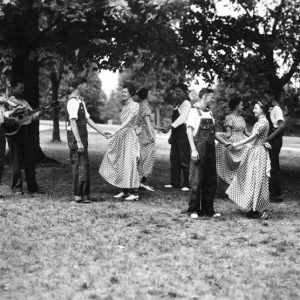calsfoundation@cals.org
Official State Dance
aka: Square Dance
In 1991, the Arkansas General Assembly designated the square dance the official American folk dance of Arkansas. A concurrent resolution authored by Senator Jack Gibson of District 35 introduced the measure; it won quick approval and was signed into law by Governor Bill Clinton on February 7, 1991, as Act 93.
Act 93 resembled measures introduced across the nation by promoters of club square dancing after an attempt to have the dance awarded national symbol status failed in 1988. The bill posited a long history of called, or “cued,” dancing in North America and Arkansas and the association of square dancing with family recreation. It defined square dancing as incorporating virtually all called or cued dances—including clogging, contra, and line dancing—and asserted that official designation would “enhance the cultural stature of Arkansas both nationally and internationally.”
Traditional square dancing incorporates elements of early English and French folk dances, including Morris dancing (performed exclusively by men) and the contredanse anglaise, a French style that took its name from the dance partners’ facing each other in lines. Brought by French and English colonists in the seventeenth century, these dances probably became staples of community entertainment, accompanied by singing, percussion, and possibly a fiddle. Square dancing enjoyed a revival in the twentieth century when touted by industrialist Henry Ford, who promoted it as a wholesome survival of the preindustrial era. After World War II, square-dancing clubs helped institutionalize what had once been a widespread but informal folk tradition.
Today, at least thirty-one states have made official the square dance’s prominence. Square-dance enthusiasts have not abandoned national aspirations: U.S. House Resolution 645 of 2003, whose co-sponsors included Arkansans Marion Berry and John Boozman, proposed to designate it the national folk dance. The measure died in committee.
For additional information:
Mangin, Julie. “The State Folk Dance Conspiracy: Fabricating a National Folk Dance.” Old-Time Herald 4 (Spring 1957): 9–12.
Netstate’s Guide to State Symbols. http://www.netstate.com/states/tables/state_dances.htm (accessed August 3, 2023).
Ware, David. It’s Official! The Real Stories behind Arkansas’s State Symbols. 2nd ed. Little Rock: Butler Center Books, 2017.
David Ware
Arkansas Secretary of State’s Office
 Arts, Culture, and Entertainment
Arts, Culture, and Entertainment Square Dance
Square Dance 




Comments
No comments on this entry yet.